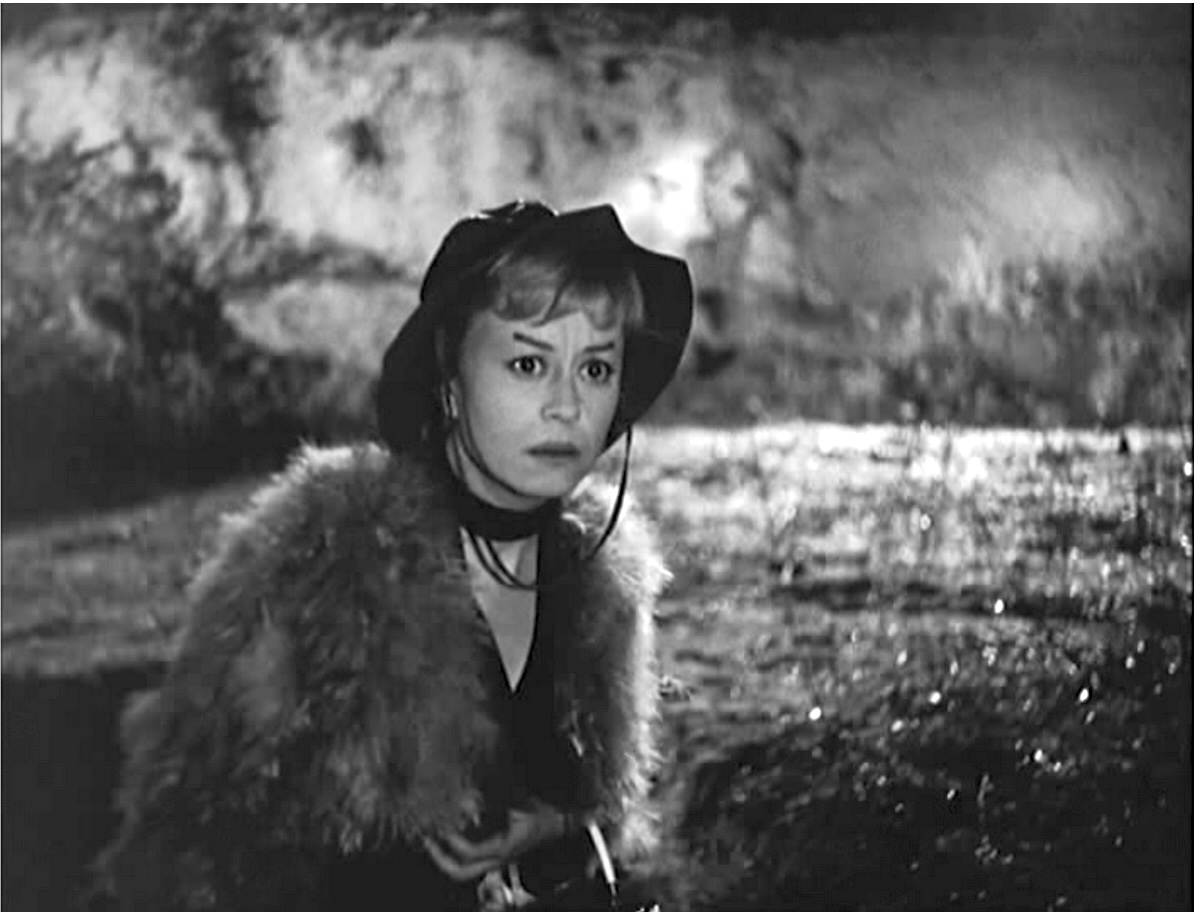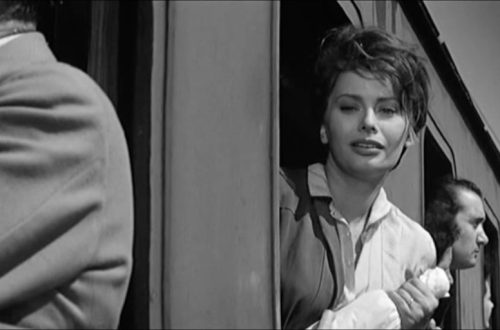Ciao a tutti at My Italian Circle!
If you’re reading this, you probably love the Italian language, and maybe you also love old Italian movies, as I do. In this article, I outline certain themes that often appear in movies made from the 1940s through the 1970s, such as language differences; the dichotomy between North and South; emigration; and the post-war economic boom. Often, these themes might pass unnoticed without some understanding of the cultural background. The information I provide here lays the basis for a deeper appreciation of the films. For example, when you see a film where a northerner makes a disparaging remark about a southerner, or where an Italian emigrant misses home, you’ll know that these are themes of Italian life and culture, and not just the experience of a single individual.
I illustrate the themes with images from some of my favorite Italian films, which include Italian subtitles translated, in some cases, from dialect. I’ve included links to the cineracconti (photo-stories) on my blog www.liconoscevobene.net, where, if your curiosity is piqued, you can read a narrative of each film, complete with dialogue, scene description, cultural notes, and images.
Language Differences
Before the unification of Italy in the mid-1800s, people in the country spoke a wide range of dialects and registers of Italian. Today, the relative isolation that sustained these language differences has gone, but the old forms have persisted somewhat, through custom or pride. Those who speak standard Italian may feel superior to dialect speakers. As we see in the following examples, other effects of this language difference may be confusion and misunderstanding; efforts by dialect speakers to speak a more standard Italian, often portrayed affectionately or for comic effect; and identification with a local region, rather than with Italy as a nation.
- In Nuovomondo, on a ship bound for Ellis Island, a short scene reveals the limits of Italian identity.
Nuovomondo / Golden Door (Emanuele Crialese, 2006)
When passengers from Petralia, Carini, and Cinisi introduce themselves, one man says, “Who has ever slept with so many foreigners?”
“Foreigners? But where are all these foreigners? We’re all Italian here!”
“Italian?”
“Italian.”
“And what language do you speak?”
“Don’t you know that we’re speaking Italian?”
- In I compagni, during an important meeting to discuss a strike, the mill workers all have an opportunity to speak out.
I compagni / The Organizer (Mario Monicelli, 1963)
After one worker shares his opinion, Giulio, a union leader says, in frustration, “I don’t know, I didn’t get a fucking thing.”
Cesarina, another leader, replies, “I did understand. It’s Bergamo dialect. My father was from there, poor guy. He proposes that, instead of quitting an hour early, to be united, we all start an hour later tomorrow morning.”
These lines carry a message from Monicelli, the director, about the importance of overcoming language divisions to forge solidarity and about acceptance of Italians who speak different languages or dialects.
- In Mafioso, when Nino brings his Northern wife to Sicily to meet his family, his sister Rosalia – a native Sicilian speaker – tries to speak standard Italian with her sister-in-law from the north.
Mafioso (Alberto Lattuada, 1962)
Rosalia explains the sleeping arrangements: “You’ll be comfortable and isolated. And no one will disturb your intimacy.” Her Italian sounds somewhat stilted.
- You may see characters in films using incorrect grammar – and being corrected or looked down upon by other characters.
Divorzio all’italiana / Divorce Italian Style (Pietro Germi, 1961)
Rosalia: “If we wasn’t to love –”
Ferdinando: “‘Weren’t. If we weren’t to love!”
Here, Ferdinando corrects his wife Rosalia’s grammar in standard Italian when she doesn’t use the subjunctive. They are Sicilian, but he is more educated. (In fact, many Italians nowadays – like many English-speakers – don’t bother with the subjunctive!)
- You may also see adults struggling with simple arithmetic. In La ciociara, a young boy asks his dad for help with a math problem. His dad doesn’t have a clue, and his grandma scolds him for even asking.
La ciociara / Two Women (Vittorio De Sica, 1960)
Boy (to father): “Dad, there are sixty walnuts in a bag. Ten people each want as many as possible. What calculation should I do?”
Grandma (to boy): “What are you going to school for? You’re the one who should be teaching us!”
While Italy’s literacy rate climbed postwar, its low rate of functional illiteracy continues.
You can read a brief overview of Italian cinema from the origins to the 1970’s on My Italian Circle’s website.
Northern Italy / Southern Italy
Given their attitudes to language, northerners sometimes disparage southerners as rural, coarse, and backward, while southerners may regard northerners as pretentious snobs.
1. In Rocco e i suoi fratelli, Rosaria Parondi, a widow, migrates to Milan from the South with her sons.
Rocco e i suoi fratelli / Rocco and his Brothers (Luchino Visconti, 1960)
When the family arrives at their new apartment complex in Milan, the porter directs them to their apartment: “Parondi, Parondi, yes, there, it’s over there. There, there, down, down, the basement.” She uses simple words, repeating herself and gesturing, so that the southerners will better understand her.
Rocco e i suoi fratelli
Not everyone is so kind. A few moments later, as the Parondis enter the courtyard, a woman says to the porter, “Did you see that stuff?”
“Mamma mia! Africa!”
“Where are they from?”
“Lucania.”
“Odd name. Where’s that?”
“Down south.”
“I see, the land of the idlers!”
To the northerner, the South may seem exotic as Africa: an unknowable place where primitive races live.
2. In Mafioso, Nino, a Sicilian living in Milan, often finds himself acting as an interpreter between the two cultures.
Mafioso
In this phone conversation, Nino tells his father-in-law, a northerner, about his upcoming family trip back to his hometown.
“No, don’t worry… What? Typhus vaccine? Papa, what do you think, that we’re going among the Mau Mau? I’m bringing them to my home!”
3. In I fidanzati, unusually, the migration is from North to South: Giovanni goes from Milan to Sicily for work.
I fidanzati (Ermanno Olmi, 1962)
On Giovanni’s new assignment, a northern coworker explains the industrial accident that has just occurred in terms of his perceptions of Sicilian culture.
“They don’t wear their welder masks… In the early days, when it rained, they wouldn’t come to work… Here, when it rains, everything stops. They don’t have an industrial mentality and there’s nothing you can do.”
Later, another northerner comments, “It’s not that they’re lazy. They do their work. They’re just a little crazy. The sun’s really hot and they never have a chance to blow off steam.”
4. In L’abbaglio, a Sicilian colonel understands cultural subtleties.
L’abbaglio / The Blunder (Roberto Andò, 2025)
After the colonel has a discussion with a local aristocrat, his lieutenant is impressed.
“Colonel, what did that man want?”
“Didn’t you understand it? My dear Ragusìn, now the barons and the mafia have started playing at revolution…”
“But… it seemed very respectful to me.”
“Lieutenant, you are a good officer, but you haven’t understood anything about Sicily.”
5. In Salvatore Giuliano, about a notorious Sicilian bandit, a journalist from Rome who is reporting on his death tries to get information from people in the village.
Salvatore Giuliano (Francesco Rosi, 1962)
He asks one local man, “What do you think of Giuliano?”
“He took from the rich, gave to the poor.”
“That’s it?”
“Yes, that’s it. Where are you from?”
“From Rome.”
“What could you understand about Sicily?”
Later, soldiers from the North go to the Sicilian town of Montelepre.
Salvatore Giuliano
The local Carabinieri marshal advises the northern major that the territory is hostile, but his input is disregarded. Instead, the marshal is ordered to accompany the lieutenant as he seeks local lodgings for the soldiers.
The marshal says, “Keep against the wall. It’s safer.”
“Don’t take offense at what the major said. We northerners are out of our element here.”
“So are we, and we’re from the town.”
Needless to say, two soldiers walking in the middle of the street are shot and killed.
Emigration
Emigration – internal and external – is a common theme in postwar Italian movies set during the Economic boom (see below), a time of social and geographic mobility. The decision to emigrate is rarely easy. It’s a dislocation. It means leaving behind everything that is familiar.
- For southerners, the reasons for leaving are often economic: hardship and poverty. In Rocco e i suoi fratelli, Signora Parondi talks about life in Sicily to her son.
Rocco e i suoi fratelli
“Tell me: is it my fault if all this is happening? Is it my fault if I wanted to bring my big, strong, beautiful sons to the city so they could get rich and not be damned on that unrewarding land like their father who died a thousand times before closing his eyes forever? … Your father couldn’t bring himself to leave the land. But for all the twenty-five years we spent together, I thought of nothing else but this: leaving, leaving, leaving.”
- Il cammino della speranza is set in a Sicilian village that depends on a sulfur mine. Told that it will close, the miners decide to stay underground until the owners reverse the decision.
Il cammino della speranza / The Path of Hope (Pietro Germi, 1950)
Underground, Saro says: “They must not close down the mine. It means making us and our families die of hunger. Better to die here.”
But the miners ultimately decide it is better to live. A trafficker offers to take the miners and their families to France.
Saro says: “I’m leaving. I have three children to feed, but it’s not only that. Children grow up and if I’ve had a life of misery, I don’t want them to have one. I want them to be able to work. They have no work here.”
- Far from home, emigrants, who may never have left their hometown before, encounter locals who may be prejudiced and hostile. They miss their lifelong friends. In La ragazza in vetrina, set in Holland, a Sicilian in the miners’ dormitory is happy when a group of Italians arrives.
La ragazza in vetrina / Girl in the Window (Luciano Emmer, 1961)
He greets them warmly. “Hey, good evening, beauties.”
“Good evening.”
“Are you all Italian?”
“Yes.”
“Good. This way, we can keep each other company. I was beginning to feel a little lonely here.”
- But everyone is aware of the distinctions, even among friends.
Il cammino della speranza
Arriving in a farmworkers’ dormitory full of northerners, the migrants in Il cammino della speranza are greeted with a question: “Where are you from?”
“From Sicily. We are Sicilians.”
“The terroni have arrived!”
“We’re terroni, but you’re polentoni!”
Note that both terms are derogatory: terroni, southerners, those who work the land (terra); polentoni, northerners, a term derived from polenta, cornmeal, eaten mostly in the North. In this case, the terms are used in good humor, but that’s not always the case.
5. In I compagni, Sicilian worker Arrò is regarded as an outsider.
I compagni
In this scene, Arrò calls up to the workers planning a strike. Looking down, one asks unkindly, referring to Arrò’s dark skin, “Who is that? The Mustafà?”
In a later scene, the strike committee visits Arrò at home.
I compagni
When they enter Arrò’s hut, they’re stunned by the poverty they see: Arrò sits on a blanket over the dirt floor; the walls are rotten boards, with rags stuffed between them to block out the cold. The children look miserable.
Scenes like this, showing the harsh conditions that migrants must endure, help us understand the severity of the hardships that drove them from their homes.
6. Sometimes, emigrants may choose to return home, even at the expense of certain urban comforts. In Stromboli, terra di Dio, some of the old-timers on the island have histories less bucolic than an onlooker might assume.
Stromboli, terra di Dio / Stromboli (Roberto Rossellini, 1950)
“We’re half-American – Strombolians back from America… We were all in New York…. I worked as a dockhand in Brooklyn and I used to make a lot of money. Imagine! On Sundays, we’d go fishing! By car!”
“I’d even drive a car to pick up my relief check. We all drove cars in America!”
“But we came back to Stromboli.”
“America is good for young people. I’m an old man and I want to die on Stromboli.”
Economic Boom
The first wave of emigration, as depicted in Nuovomondo (see above), followed Italian unification in the mid-19th century. The second wave took place after World War II during a period known as the “boom” or “economic miracle”. The boom created a new middle class with well-paid jobs and consumer goods. For some, it meant upward mobility.
- In Mafioso, Nino’s kitchen in Milan is full of the latest appliances.
Mafioso
- But there’s a darker side to the boom. In Le mani sulla città, construction in a densely populated neighborhood of Naples results in the sudden collapse of an adjacent building.
Le mani sulla città / Hands over the City (Francesco Rosi, 1963)
Afterwards, accusations fly: real estate speculation, the violation of building codes. The film gives a sharp perspective on the corruption that ensues when city government is enmeshed with private interests.
- When you see construction in a post-war Italian film, even in the background of a shot, it’s likely a symbol of the boom – and often an unspoken comment on those left behind by the boom.
Le notti di Cabiria / Nights of Cabiria (Federico Fellini, 1957)
In these images from Le notti di Cabiria, Cabiria’s boyfriend steals her pocketbook, she runs to look for her shoe, and local residents try to help her. In the background, in each case, we see new and ongoing construction, a clear statement by the filmmaker that accompanies the action.
Le notti di Cabiria
Then we see where Cabiria lives. Later, we see the caves where the cast-off live – and where Cabiria might end up herself.
- In Miracolo a Milano, tall buildings constructed during the boom provide a silent commentary on the lives of shantytown residents.
Miracolo a Milano / Miracle in Milan (Vittorio De Sica, 1951)
The contrast is shocking.
Miracolo a Milano
In the film’s finale, the shantytown residents fly into the heavens because – boom or no boom – there is no place in the city for them to live.
In this brief survey, I’ve noted some of the common themes in postwar Italian films. With that background, you should be able to recognize these topics when they come up in your movie watching. If you want to learn more, there is plenty of material online. And our cineracconti provide a complete overview of most of the films mentioned here, including dialogue, images, scene descriptions, and cultural and historical notes.
Thanks for reading, and hope to see you on our blog soon!
Judy Cohen
judycohen.iknewthemwell@gmail.com
www.liconoscevobene.net/subscribe
with
Editor: Alberto Maio
Italian teacher reviewer: Michela Badii
Proofreader: Lucrezia Grussani






This article was so impressive! The interaction, movie,vocal and explainations were all engaging!
I agree with Gloria. Impressive work, and very, very useful in class to engage students with the topic of cultural diversity!
Brilliant article! Clear, insightful, and full of inspiration. The contrast between northern and southern dialects and the social commentary are especially striking. A truly valuable read!